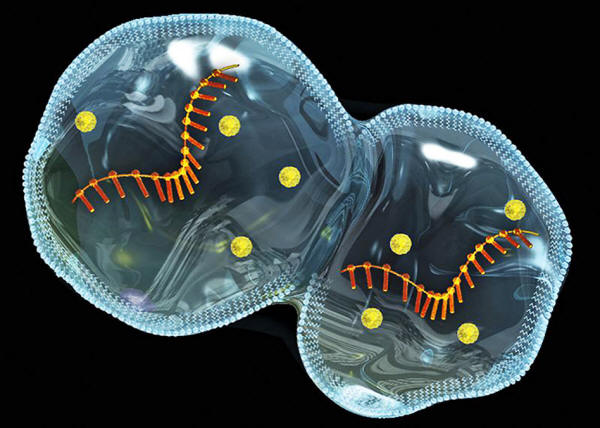|
by Sara Imari Walker 01 May 2019 from Nature Website
A protocell (artificial cell) dividing to produce two daughter cells. An artist's impression of early 'protocells' proliferating. Credit: Henning Dalhoff/Science Photo Library
Stuart Kauffman's provocative take on emergence and evolution
energizes Sara
Imari Walker.
The Emergence and
Evolution of Life Stuart A. Kauffman Oxford University Press (2019)
Scientists have probed it since the 1920s, when biochemists Alexsandr Oparin and J. B. S. Haldane (separately) investigated the properties of droplets rich in organic molecules that existed in a 'prebiotic soup' on the primitive Earth (see T. Hyman and C. Brangwynne Nature 491, 524–525; 2012).
Each hypothesized that
organic compounds underwent reactions leading to more complex
molecules, and eventually to the first life forms.
Decades after Oparin and Haldane, Erwin Schrödinger's 1944 book What Is Life? (see P. Ball Nature 560, 548-550; 2018) attempted to lay conceptual foundations for such a theory.
Yet, more than 70 years
and two generations of physicists later, researchers still ponder
whether the answers lie in unknown physics. No one has led the
charge on these questions quite like Stuart Kauffman.
He posited that if a chemical soup of polymers was sufficiently diverse, these sets would emerge spontaneously as a phase transition - that is, a significant change in state or function, akin to the shift from solid to liquid.
The sets function holistically, mutually catalyzing the formation of all their molecular members.
(His inspiration was advances in the mathematics of networks by Paul Erdős and Alfréd Rényi, who had demonstrated how phase transitions occur in random networks as connectivity is increased.)
Now, in
A World Beyond Physics,
Kauffman elaborates.
Once they start interacting to form molecules, the number of possible states becomes mind-bogglingly massive.
Only a tiny number of
proteins that are modestly complex - say, 200 amino acids long -
have emerged over the entire history of the Universe. Generating all
20020 of the possibilities would take aeons. Given such
limitations, how does what does exist ever come into being?
He posits that auto-catalyzing sets (of RNA, peptides or both) encapsulated in a sphere of lipid molecules could form self-reproducing protocells. And he speculates that these protocells could evolve.
Thus, each new biological innovation begets a new functional niche fostering yet more innovation.
You cannot predict what
will exist, he argues, because the function of everything biology
generates will depend on what came before, and what other things
exist now, with an ever-expanding set of what is possible next.
He writes:
At best, he argues, any 'laws of life' that do exist will describe statistical distributions of aspects of that evolution. For instance, they might predict the distribution of extinctions.
Life's emergence might rest on the foundations of physics,
If biology cannot be reduced to physics, however,
This is an interesting time to work on life's origins:
Those approaches are being developed as an international effort, which coalesced in the 2015 conference Re-Conceptualizing the Origins of Life, drawing researchers from institutions including,
The distinction might be
semantic, but it is important.
Interesting work is emerging from the study of complexity in areas such as,
Such cross-disciplinary advances suggest that physics itself should not be defined merely by systems it has described in the past.
It is a way to view the world, one that values the most abstract, fundamental and unifying descriptions of reality, from atoms to the Universe. Within that span is biological and technological complexity in phenomena from humans to cities.
So far, this has been the hardest area in which to gain traction from first-principles approaches, because of the density of interactions across components and scales.
The question of whether there is a physics of life demands that we consider that all examples of life might at their core be part of the same fundamental phenomenon; otherwise, 'life' is not an objective property, but a collection of special cases.
This unified view seems to be in line with what Kauffman is after.
But it suggests that an explanation might demand new physics.
After all, some physical laws are statistical by nature, such as the second law of thermodynamics. But conventional approaches to life's origins - such as the 'RNA world' and other genetics-first models - cannot yet be formulated in this way.
That is because they make
many assumptions on the basis of properties that might be unique to
the chemistry of life on Earth, such as that RNA is necessary to
life's origins.
(The chemist Lee Cronin, for example, experiments on self-assembly and self-organization in large molecules such as metal oxides.)
In this sense, the field
is attempting to take an ensemble approach, and could provide new
paths for developing theories on the universal principles bridging
non-organic matter and life. It might inspire the next conceptual
leap.
But there is much work
for the next generation to do to answer them.
|


